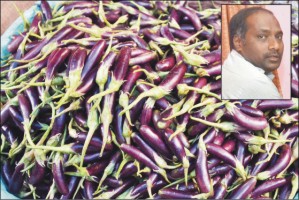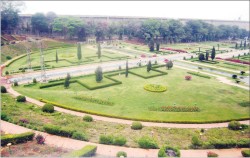Mangalore :
With an aim to create awareness on the necessity to protect the environment, a maiden ‘Parisara Sahitya Sammelana’ (literary conference on environment) was held on Thursday April 24 in a makeshift setup that resembled a forest near Shediguri at Ashok Nagar here.
The conference was organized by National Environment Protection Union with an aim to garner support to work towards the protection of environment.
The conference expressed stiff opposition to the proposed Yettinahole project, displaying leaflets sent through posts to the organizers by many school children across the district. The display was inaugurated by artist Dinesh Holla in a unique way by painting and writing a poem.
Addressing the gathering after inaugurating the environment conference, environment journalist Nagesh Hegde expressed his discontent over human greed that has been turning out as a tragic curse to mother earth. “Human ever since his advent on the earth has indulged in destroying the environment around him for his own benefits, neglecting the importance of the earth,” he said.
Adding a touch of imagination to the scientific definition of the evolution of the earth, he said, “Imagine that the earth is now 46 years old, which means the earth was born 46 years back. When the earth was one year old 45 years ago, it started to cool itself to make the conditions suitable for living. The process went on till it reached 40 years. At the age of 42, rain lashed the earth further cooling the heat and enabling the earth to support life on its surface. As a result, at 43, the first flower blossomed beautifying the mother. At the age of 45, dinosaurs made their way to earth and vanished in a year.
“Currently the earth is aged 46. Nine months back mammals came into existence, one week back apes started to roam around the earth and 4 hours back humans started walking on the earth. An hour back, the human started to till the arable land learning agriculture. A minute back he studied to drill the land for petrol and coal ransacking the earth, leaving its womb damaged. His greed minute by minute is growing on a distructive mode further drying up the ground water,” he said.
“The population of the world has reached 750 crore milling on the earth, with man encroaching the maximum land, doubling his vicious aspirations and killing nature. At least now we have to understand the importance of protection of nature for a sustainable living,” said, appreciating the initiative of the organizers to spread awareness on the necessity of preserving the environment.
Prior to the formal programme, book stalls and herbal products stalls were inaugurated by the guests.
On the occasion litterateur Dr Na D’Souza, bureau chief of Prajavani Balakrishna Puttige, president of Ramakrishna Math Sri Jitakamananda Swamiji, environment columnist Dr Narendra Rai Derla, professor of Milagres College A A Richard Rebello and others were present.
source: http://www.daijiworld.com / DaijiWorld.com / Home> Top Stories / by Daijiworld Media Network (SHS) / Mangalore – April 24th, 2014






